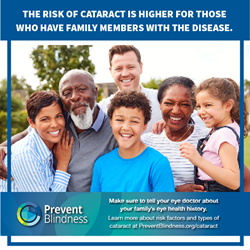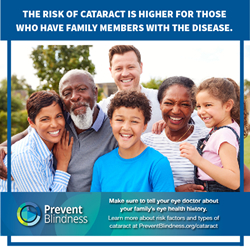
Prevent Blindness declares June as Cataract Awareness Month to educate the public on the world’s leading cause of blindness.
“Unlike many of the other major eye diseases, such as glaucoma or diabetes-related eye disease, cataracts can be easily and painlessly treated by surgery to remove and replace the eye’s lens, restoring sight for most patients,” said Jeff Todd, Prevent Blindness president and CEO.
CHICAGO (PRWEB)
May 30, 2023
Cataract is the leading cause of blindness worldwide, according to The International Agency for the Prevention of Blindness. More than half of all Americans will have cataract by the time they are 80 years old. Prevent Blindness, the nation’s leading nonprofit eye health and safety organization, has once again declared June as Cataract Awareness Month in an effort to provide patients, care partners and professionals with information on topics related to types of cataract, risk factors, symptoms, cataract surgery and available financial assistance resources. The group offers a dedicated web resource at PreventBlindness.org/cataract, and free materials in English and Spanish, such as fact sheets and social media graphics.
Prevent Blindness also offers the “Understanding Cataract” episode of its “Focus on Eye Health Expert Series.” Prevent Blindness president and CEO Jeff Todd discusses cataract and cataract surgery with Albert Cheung, MD, Cataract, Cornea, Anterior Segment Specialist with Virginia Eye Consultants and Assistant Professor at Eastern Virginia Medical School, Department of Ophthalmology.
Cataract is a clouding of the eye’s lens that blocks or changes the passage of light into the eye, according to the National Eye Institute.
Although there may be no early symptoms, patients may begin to notice:
- cloudy or blurry vision
- colors that look faded
- difficulty seeing at night
- lamps, sunlight or headlights appearing too bright
- a halo around lights
- seeing double (this sometimes goes away as the cataract gets bigger)
- frequent changes to the prescription of eyeglasses or contact lenses
Cataract surgery is one of the most common operations in the United States. An average of 4 million cataract surgeries are performed in this country every year, according to the American Academy of Ophthalmology (AAO). For patients looking for more information, Prevent Blindness offers the dedicated webpage, PreventBlindness.org/cataract-surgery, and the printable “Guide to Cataract Surgery” fact sheet.
If surgery is recommended, the eye surgeon may remove the lens with the cataract and replace it with an intraocular lens (IOL). The eye surgeon implants the IOL in about the same place as the natural lens, so that it results in the most natural vision.
Types of IOLs include:
- Monofocal IOL: This IOL is most commonly used. It is usually used to correct for distance vision. Using this IOL option means that patients will likely still use glasses for close vision.
- Multifocal IOL: These IOLs provide both distance and near correction at the same time.
- Accommodative IOL: These lenses move or change shape inside the eye, allowing correct vision at different distances.
- Toric IOL: This lens is used for those with astigmatism.
“Unlike many of the other major eye diseases, such as glaucoma or diabetes-related eye disease, cataracts can be easily and painlessly treated by surgery to remove and replace the eye’s lens, restoring sight for most patients,” said Mr. Todd. “We urge patients to work with their eye doctor to understand their diagnosis and the best available treatment options.”
For free information on cataract or cataract surgery, please visit PreventBlindness.org/cataract. For a listing of vision care financial assistance programs in English or Spanish, visit PreventBlindness.org/vision-care-financial-assistance-information/.
About Prevent Blindness
Founded in 1908, Prevent Blindness is the nation’s leading volunteer eye health and safety organization dedicated to fighting blindness and saving sight. Focused on promoting a continuum of vision care, Prevent Blindness touches the lives of millions of people each year through public and professional education, advocacy, certified vision screening and training, community and patient service programs and research. These services are made possible through the generous support of the American public. Together with a network of affiliates, Prevent Blindness is committed to eliminating preventable blindness in America. For more information, visit us at PreventBlindness.org, and follow us on Facebook, Twitter, Instagram, LinkedIn and YouTube.
###
Share article on social media or email:

